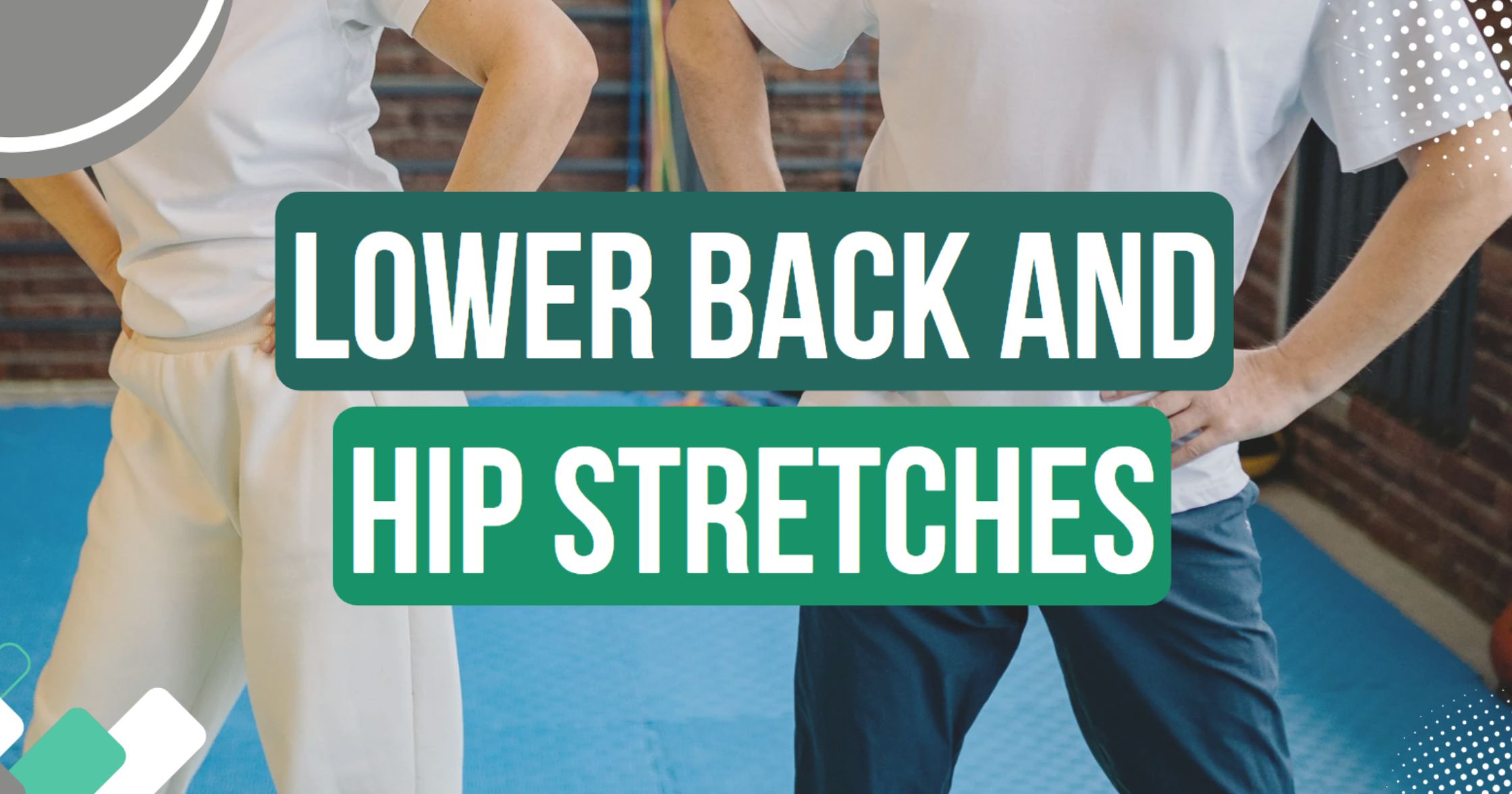
Essential Lower Back and Hip Stretches
Lower back and hip stretches don't have to be hard. Honestly, it takes just a few minutes, and the relief can be long-lasting. I like to refer to the hips and lower back as the lumbopelvic complex. They are so closely related that you can’t stretch one without stretching the other. This also makes sense when discussing hip and lower back treatment. We need to treat the lumbopelvic complex, both the hips and lower back, to have long-lasting relief.
Let’s go through some of the best ways to stretch your hips and lower back throughout your day.
Disclaimer: Although these treatments have been effective for many people, including evidence-based approaches, the best approach is to undergo a comprehensive physical examination with a healthcare provider.
7 Easy Stretches to Release Your Lower Back and Hips
These stretches are among my absolute favorites for the lower back and hips. They address hip flexors, glutes, piriformis, hamstrings, and back muscles. Some of these exercises target both areas simultaneously, while others are designed to isolate specific muscles for a more targeted approach. Any combination of these will work great when performed regularly, so go ahead, give them a try and see how much better you feel.
If you are looking for more stretching routines or even strengthening for the lower back and hips, check out my PDFs. They are very detailed and will help feel better and stronger no time!
1. Standing Hip Flexor Stretch
- Step one foot on a chair or stool and go into a lunge position while keeping the other leg extended behind you.
- Tuck your pelvis slightly under as if you were rounding your spine, and shift your pelvis forward.
- Maintain a straight back.
The stretch will be felt in the front of the hip, hold it for 2-3 seconds and shift back to the starting position. Repeat 10-20 times, repeat 2-3 times on each side.


2. Standing Hamstring Stretch
- Straighten one leg on a chair with the heel resting on the chair.
- Maintain a neutral back position, keep your chest pointing up, and bend forward at the hips.
Stretch will be felt in the back of the straight thigh, hold it for 2-3 seconds, and return to the starting position. Repeat 20 times on each side.

3. Piriformis Stretch
- While laying down, place the outside bone of one ankle on top of the other thigh, right above the knee.
- For most people this is enough of a stretch already, but if you want to increase the intensity, gently pull up from the back of the thigh to increase the stretch.
The stretch will be felt in the buttock area, hold it for 2-3 sec then return to starting position. Repeat 10-20 times on each side.
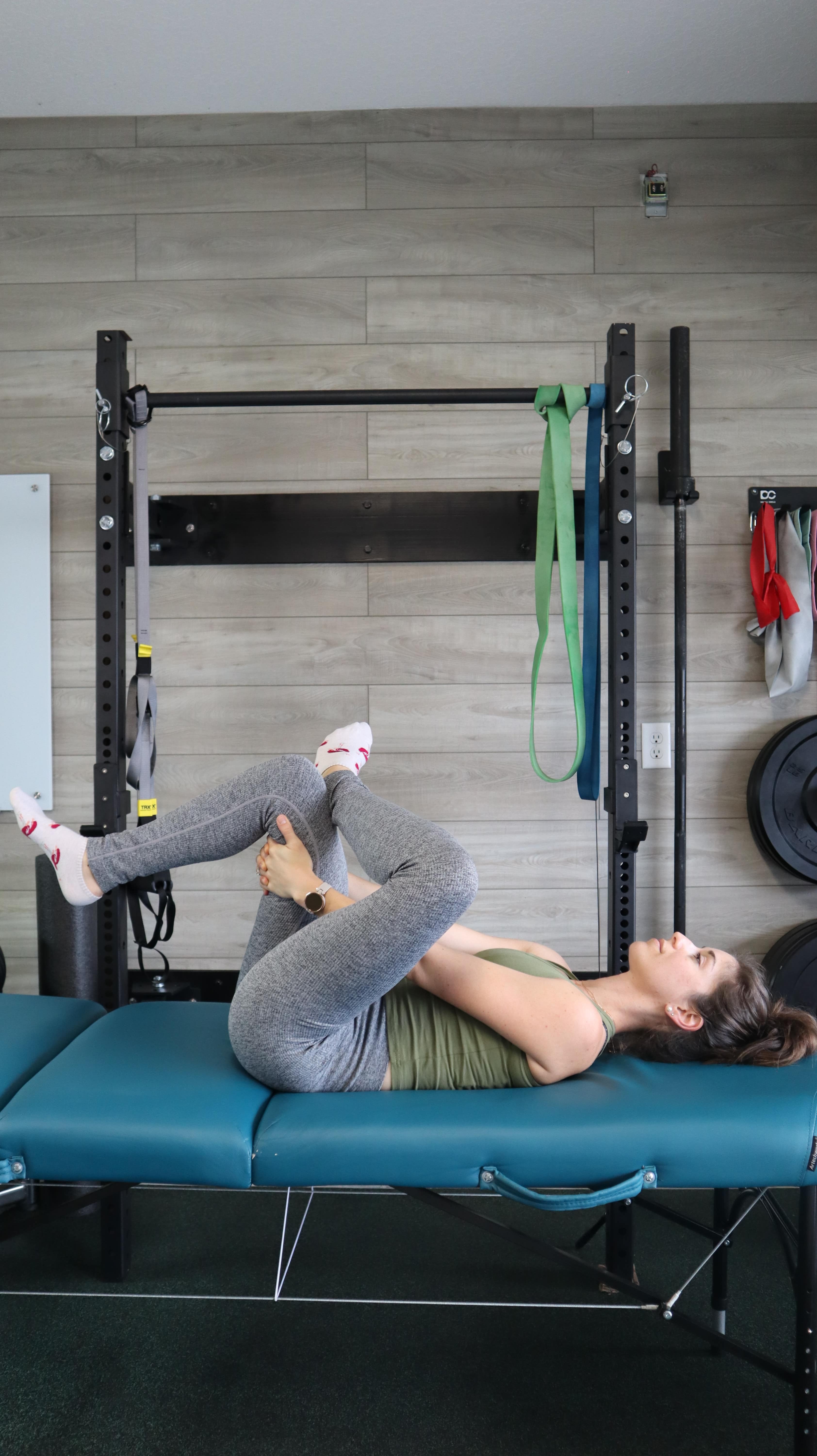
4. Knees to Chest (Glutes Stretch)
- Lie flat on your back and bring both knee to your chest, giving it a gentle pull with your hands.
- Hold the stretch for 2-3 seconds then back off to release tension.
- Repeat 20 times.
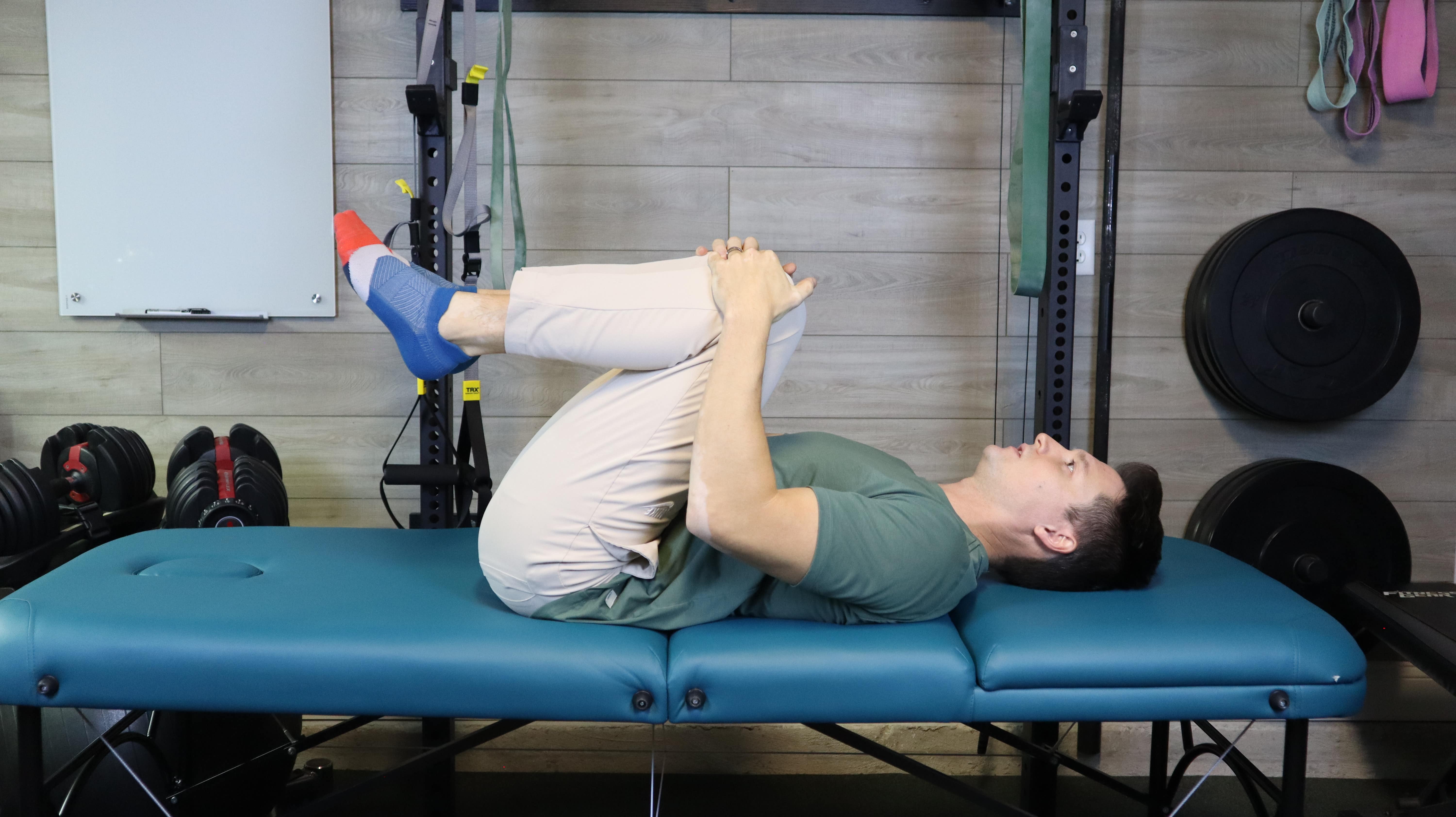
5. Child's Pose
- Start on all fours and then sit back on your heels.
- Bend forward while extending your arms forward until your forehead rests comfortably on the floor (or a prop such as a yoga block or small pillow if unable to reach the floor).
- Breath slowly into your lower back while holding this position 20-30 seconds. Repeat 2-3 times.

6. Cat and Camel
- Start on all fours with neutral neck position.
- During exhalation, gently round your back like an angry cat while looking down and hold 2-3 seconds
- Next, while inhaling, let your back return to neutral and continue down to gently arch your back, hold 2-3 seconds.
- Repeat this sequence 20 times.

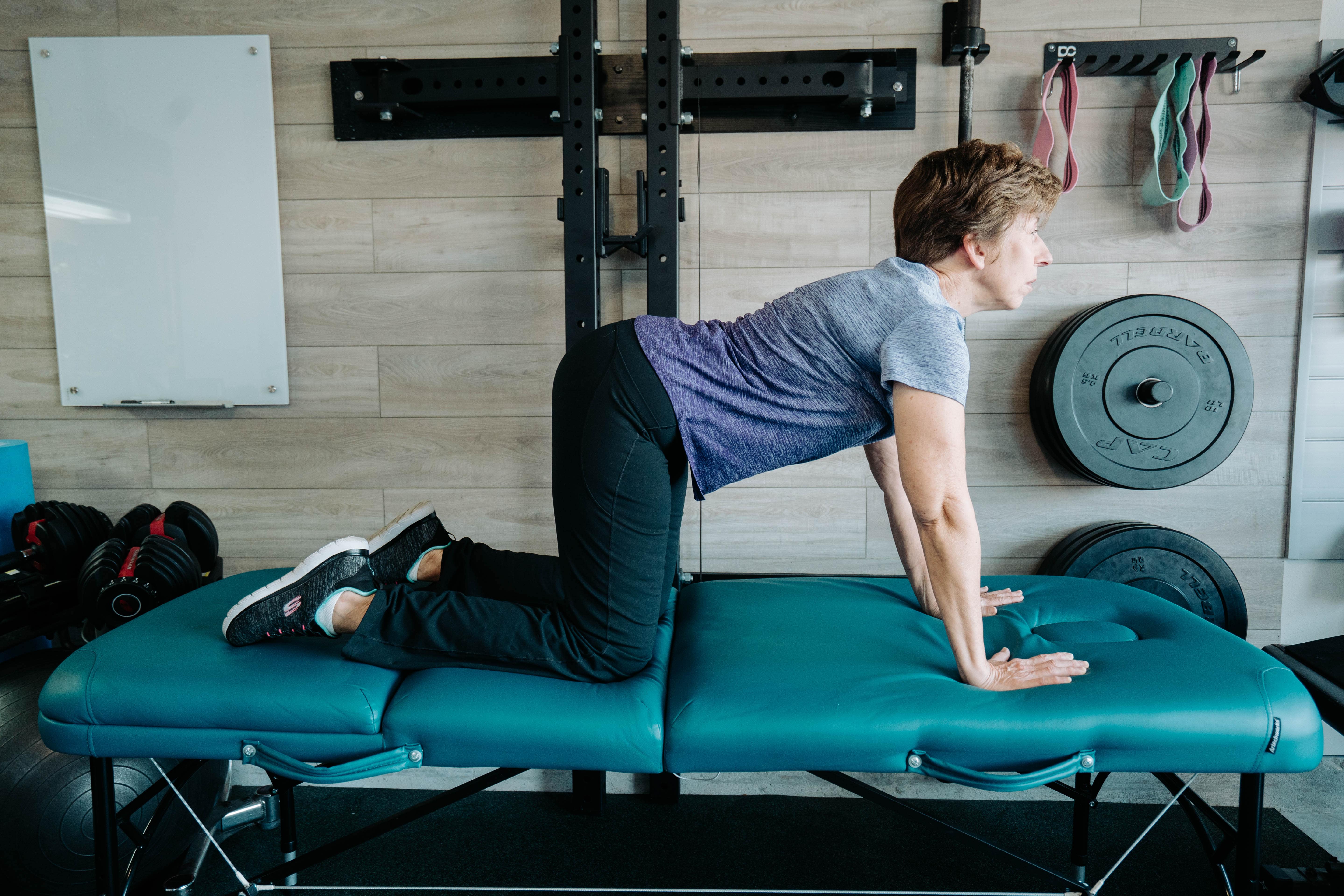
7. Trunk Rotation Stretch
- Start laying on your back with both knees bent and feet shoulder-width apart.
- Bring your arms to your side.
- Keeping your feet in place, slowly move your knees to one side as far as they will go, hold 2-3 seconds, and reverse motion in the other direction.
- Repeat this "windshield wipers" movement slowly from side to side.
- Repeat 15 times on each side with 1 second holds.


These stretches are suitable for almost anyone, but, as with any other exercise, stay present and mindful about how your body feels and how it responds to these movements. It is completely normal and safe to experience tightness, stiffness, or occasional discomfort during stretching. However, you should pause any exercise and ask your physical therapist for modifications if the exercise is eliciting sharp or shooting pain, changes in sensation or any other unusual symptoms.
The Importance of Lower Back and Hip Stretches
The importance of stretching cannot be overstated. When our lower back and hip muscles are tight or stiff it's so annoying. Mobility is earned with your dediacation and efforts.
Consistent stretching breaks this cycle and allows us to maintain full mobility and good balance between flexibility and strength, thereby reducing the risk of developing back or hip pain in the future.
Stretching is one of the best ways to invest in the health of your hips and spine. It's easy, quick, and provides an instant boost to how you feel. Like previously stated, stretching isn't hard, but everyone is unique and has different needs. If you're the DIY type, you can start with general low-back and hip stretches, which I've listed below. If you want to take it a step further check out my diagnostic quiz to help you dial in your stretches and exercises for your condition.
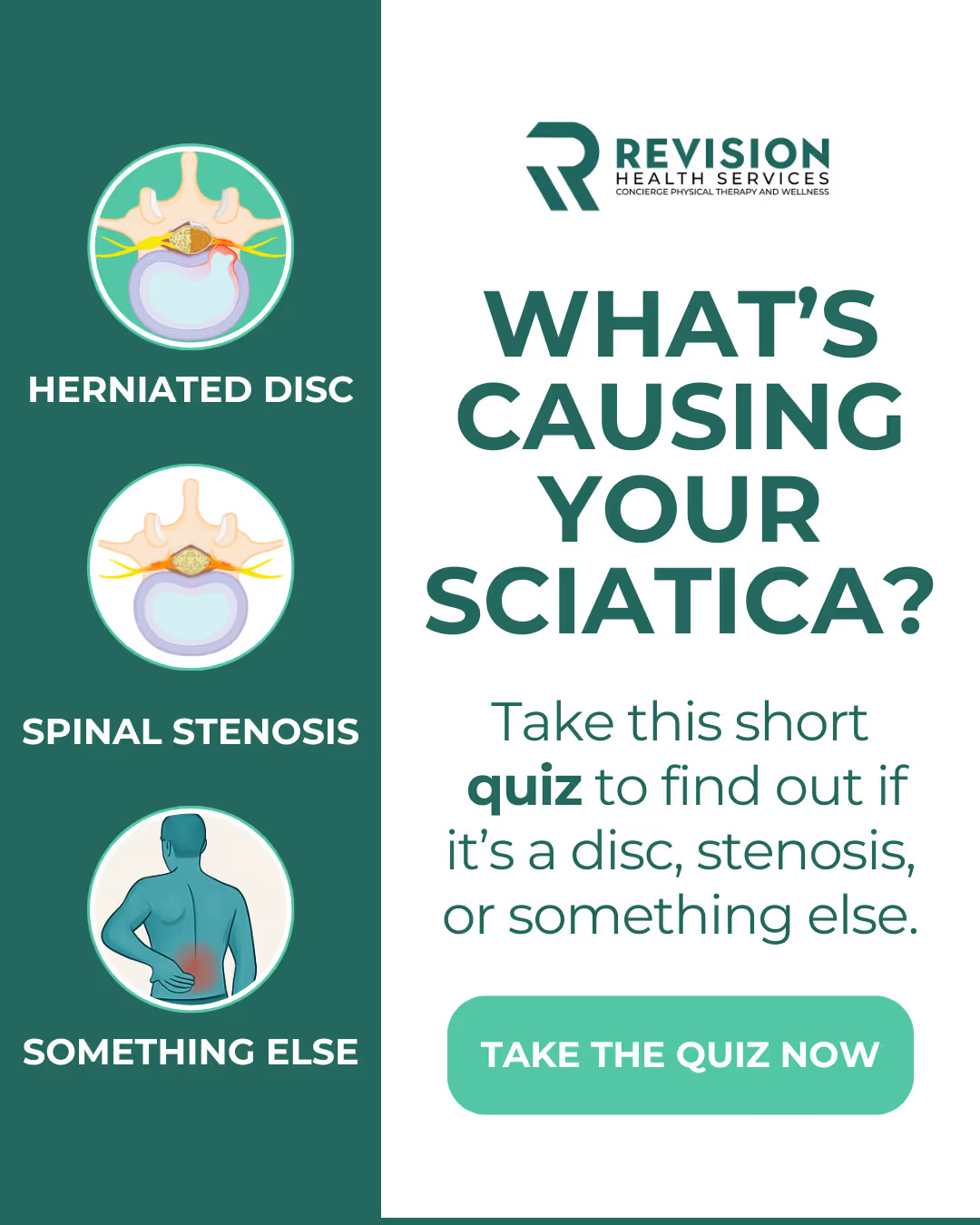
Top 3 Things to Consider When Stretching Your Hips and Lower Back
I have never heard of someone feeling worse after they loosen up their hips and lower back. Dialing in the perfect routine for your body can be challenging, but that’s why learning your body and trying different stretches is important. Hip and lower back pain stretches are essential to help people avoid more invasive treatments.
However, there are some things to keep in mind:
- There is no one-size-fits-all approach. After years of treating hip and lower back pain, you quickly learn that if you treat everyone the same, people don't achieve the outcomes they deserve. The first step should be determining whether your pain is true hip or lower back pain.
- I would try stretching, strengthening, and other conservative measures before pursuing imaging such as an MRI. The risk of something seriously wrong is low, and MRIs have an increased likelihood of receiving surgery, injections, etc. MRIs for lower back pain are not as necessary as some may think!
- Soreness doesn’t equal harm. Your body needs to be a little sore. Growth is always uncomfortable. To loosen up tight lower back muscles, you need a good amount of force and tension through the muscles. The best outcomes occur when stretching is followed by strengthening. After learning to stretch, it can be helpful to learn what exercises to avoid with lower back pain.
Summary
Stretching your hips and lower back is key not only for relief but also longevity. It takes time and effort and the stretches I reviewed today will help you be successful. Try them out and let me know if you have any questions. If you are looking to take things a step further then check out my book or related PDFs to help you find and develop the perfect routine for you!
Lower back and hip stretches don't have to be hard. Honestly, it takes just a few minutes, and the relief can be long-lasting. I like to refer to the hips and lower back as the lumbopelvic complex. They are so closely related that you can’t stretch one without stretching the other. This also makes sense when discussing hip and lower back treatment. We need to treat the lumbopelvic complex, both the hips and lower back, to have long-lasting relief.
Let’s go through some of the best ways to stretch your hips and lower back throughout your day.
Disclaimer: Although these treatments have been effective for many people, including evidence-based approaches, the best approach is to undergo a comprehensive physical examination with a healthcare provider.
7 Easy Stretches to Release Your Lower Back and Hips
These stretches are among my absolute favorites for the lower back and hips. They address hip flexors, glutes, piriformis, hamstrings, and back muscles. Some of these exercises target both areas simultaneously, while others are designed to isolate specific muscles for a more targeted approach. Any combination of these will work great when performed regularly, so go ahead, give them a try and see how much better you feel.
If you are looking for more stretching routines or even strengthening for the lower back and hips, check out my PDFs. They are very detailed and will help feel better and stronger no time!
1. Standing Hip Flexor Stretch
- Step one foot on a chair or stool and go into a lunge position while keeping the other leg extended behind you.
- Tuck your pelvis slightly under as if you were rounding your spine, and shift your pelvis forward.
- Maintain a straight back.
The stretch will be felt in the front of the hip, hold it for 2-3 seconds and shift back to the starting position. Repeat 10-20 times, repeat 2-3 times on each side.


2. Standing Hamstring Stretch
- Straighten one leg on a chair with the heel resting on the chair.
- Maintain a neutral back position, keep your chest pointing up, and bend forward at the hips.
Stretch will be felt in the back of the straight thigh, hold it for 2-3 seconds, and return to the starting position. Repeat 20 times on each side.

3. Piriformis Stretch
- While laying down, place the outside bone of one ankle on top of the other thigh, right above the knee.
- For most people this is enough of a stretch already, but if you want to increase the intensity, gently pull up from the back of the thigh to increase the stretch.
The stretch will be felt in the buttock area, hold it for 2-3 sec then return to starting position. Repeat 10-20 times on each side.

4. Knees to Chest (Glutes Stretch)
- Lie flat on your back and bring both knee to your chest, giving it a gentle pull with your hands.
- Hold the stretch for 2-3 seconds then back off to release tension.
- Repeat 20 times.

5. Child's Pose
- Start on all fours and then sit back on your heels.
- Bend forward while extending your arms forward until your forehead rests comfortably on the floor (or a prop such as a yoga block or small pillow if unable to reach the floor).
- Breath slowly into your lower back while holding this position 20-30 seconds. Repeat 2-3 times.

6. Cat and Camel
- Start on all fours with neutral neck position.
- During exhalation, gently round your back like an angry cat while looking down and hold 2-3 seconds
- Next, while inhaling, let your back return to neutral and continue down to gently arch your back, hold 2-3 seconds.
- Repeat this sequence 20 times.


7. Trunk Rotation Stretch
- Start laying on your back with both knees bent and feet shoulder-width apart.
- Bring your arms to your side.
- Keeping your feet in place, slowly move your knees to one side as far as they will go, hold 2-3 seconds, and reverse motion in the other direction.
- Repeat this "windshield wipers" movement slowly from side to side.
- Repeat 15 times on each side with 1 second holds.


These stretches are suitable for almost anyone, but, as with any other exercise, stay present and mindful about how your body feels and how it responds to these movements. It is completely normal and safe to experience tightness, stiffness, or occasional discomfort during stretching. However, you should pause any exercise and ask your physical therapist for modifications if the exercise is eliciting sharp or shooting pain, changes in sensation or any other unusual symptoms.
The Importance of Lower Back and Hip Stretches
The importance of stretching cannot be overstated. When our lower back and hip muscles are tight or stiff it's so annoying. Mobility is earned with your dediacation and efforts.
Consistent stretching breaks this cycle and allows us to maintain full mobility and good balance between flexibility and strength, thereby reducing the risk of developing back or hip pain in the future.
Stretching is one of the best ways to invest in the health of your hips and spine. It's easy, quick, and provides an instant boost to how you feel. Like previously stated, stretching isn't hard, but everyone is unique and has different needs. If you're the DIY type, you can start with general low-back and hip stretches, which I've listed below. If you want to take it a step further check out my diagnostic quiz to help you dial in your stretches and exercises for your condition.

Top 3 Things to Consider When Stretching Your Hips and Lower Back
I have never heard of someone feeling worse after they loosen up their hips and lower back. Dialing in the perfect routine for your body can be challenging, but that’s why learning your body and trying different stretches is important. Hip and lower back pain stretches are essential to help people avoid more invasive treatments.
However, there are some things to keep in mind:
- There is no one-size-fits-all approach. After years of treating hip and lower back pain, you quickly learn that if you treat everyone the same, people don't achieve the outcomes they deserve. The first step should be determining whether your pain is true hip or lower back pain.
- I would try stretching, strengthening, and other conservative measures before pursuing imaging such as an MRI. The risk of something seriously wrong is low, and MRIs have an increased likelihood of receiving surgery, injections, etc. MRIs for lower back pain are not as necessary as some may think!
- Soreness doesn’t equal harm. Your body needs to be a little sore. Growth is always uncomfortable. To loosen up tight lower back muscles, you need a good amount of force and tension through the muscles. The best outcomes occur when stretching is followed by strengthening. After learning to stretch, it can be helpful to learn what exercises to avoid with lower back pain.
Summary
Stretching your hips and lower back is key not only for relief but also longevity. It takes time and effort and the stretches I reviewed today will help you be successful. Try them out and let me know if you have any questions. If you are looking to take things a step further then check out my book or related PDFs to help you find and develop the perfect routine for you!




%20Blog%20thumbnails%204.avif)
